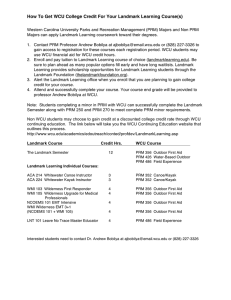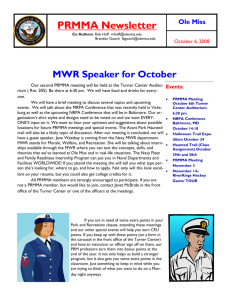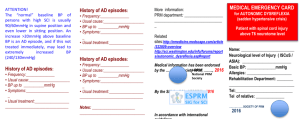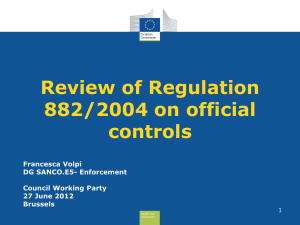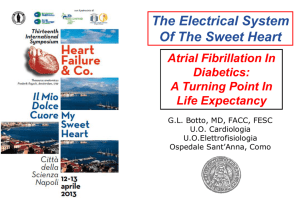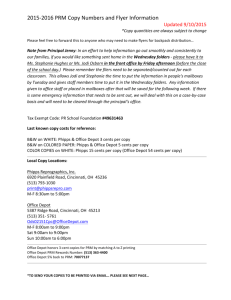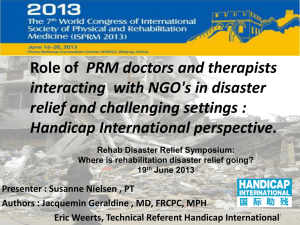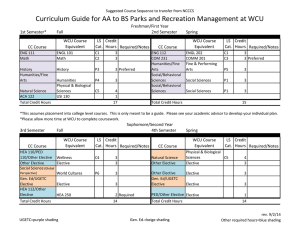Bachelor of Science in Parks and Recreation Management
advertisement
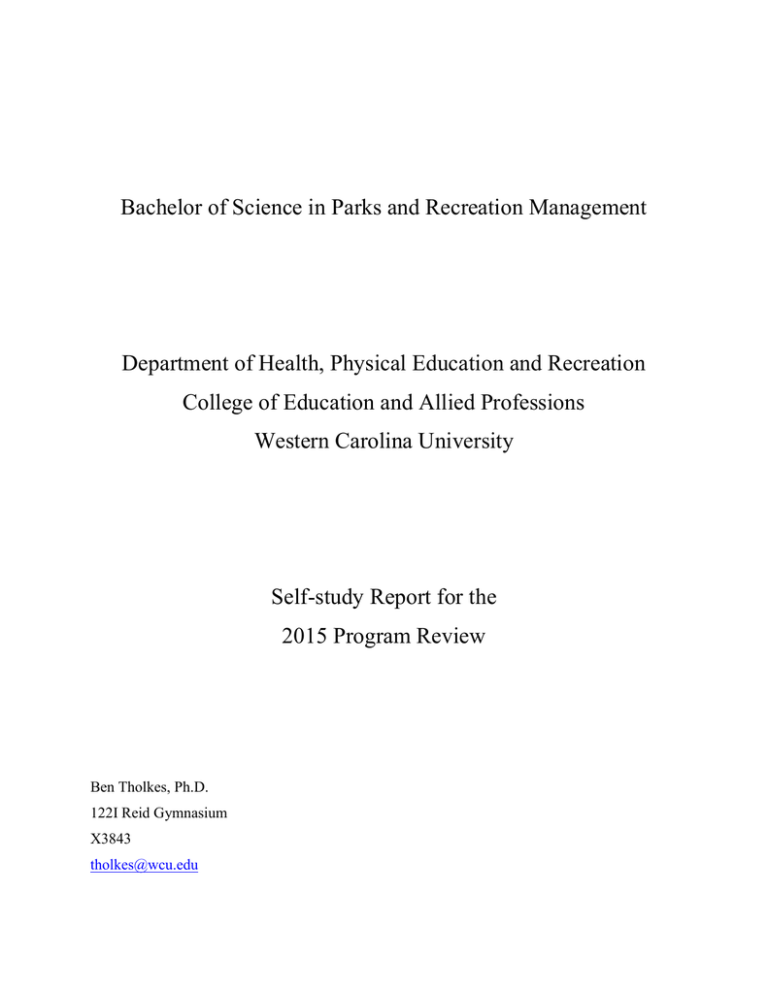
Bachelor of Science in Parks and Recreation Management Department of Health, Physical Education and Recreation College of Education and Allied Professions Western Carolina University Self-study Report for the 2015 Program Review Ben Tholkes, Ph.D. 122I Reid Gymnasium X3843 tholkes@wcu.edu 1 Executive Summary The Parks and Recreation Management (PRM) program resides in the Department of Human Services (HS) and the College of Education and Allied Professions (CEAP) at Western Carolina University. The Parks and Recreation Management program takes pride in being involved in all aspects of department, college and university initiatives. The 2013 WCU program prioritization initiative, selected the PRM program as one of only eight WCU major programs marked as exemplary and selected for enhancement by the Office of the Provost (Appendix 8.2). In addition, for the past two years (2014 and 2015), Western Carolina University has been voted the #1 Adventure College in the Southeast and Mid-Atlantic by readers of Blue Ridge Outdoors magazine. This added exposure has brought new majors to the PRM program (majors doubled from 2014 to 2015) (Appendix 8.3). The PRM program at Western Carolina University (WCU) has a long and distinguished history. In 1973, the program was created under the name of Recreation Leadership. Prior to 1992, the PRM program included Recreation Leadership and Hospitality Management. In 1992, Dr. Maurice Phipps facilitated the change of the Hospitality Management Program to emphasize outdoor recreation and outdoor education. This modification was made to enable a better fit with the Western North Carolina region and the goals of Western Carolina University. In 1993, Dr. Ben Tholkes was hired, which brought the number of tenure track faculty up to two for the program. In the fall of 2014, Dr. Phipps went on phased retirement (teaching spring semesters 2015, 2016 & 2017) and Dr. Andrew Bobilya joined the PRM faculty. In the fall of 2015, Instructor Debby Singleton became a full-time PRM faculty member after serving for 19 years in a position split between PRM and Health and Physical Education. In addition, qualified and valuable adjunct professors currently teach a number of our courses. Dr. Tholkes and Dr. Phipps have provided stability and consistency for the past twenty-three years while making significant improvements to the program. At one point, the PRM program grew to over 115 majors that proved to be challenging for 2.5 faculty in providing advisement, management of program needs, and covering the demand for more course offerings. Even with the current limitation of three full time faculty members, the PRM program has demonstrated steady enrollment, curricular improvements, and a high graduation rate. In alignment with the 2013 WCU Program Prioritization Plan, the addition of much needed resources and additional faculty members would allow the PRM program to expand into the vital 2 areas of community recreation, community health and wellness, and a proposed master’s degree in Experiential Education. The increase in resources and faculty would allow the program to develop new courses and offer classes in the curriculum not recently taught. These changes could result in significant benefits to the university and to the wider Western North Carolina community. Future growth of the PRM program, national accreditation, and a graduate program are dependent on funding and resources from the college and university. The following selfstudy report provides a brief overview of the Program according to the seven standards for Program Review as directed by the Provost Office of Western Carolina University. Supportive documentation is provided in separate appendices, which include significant data and background for the conclusions that follow. Significance and Scope of the Program Standard 1. The purpose of the program reflects and supports the mission and strategic vision of Western Carolina University and the mission of its School and/or College. Purpose and Mission: The mission of the Parks and Recreation Management (PRM) program is to promote resourcefulness, independent thinking, the ability to cope with change, and service to society – by preparing leaders in the Parks and Recreation profession. The program strives to maintain an intellectual and caring environment through cooperation and collaboration in active learning and critical thinking. Experiential education is also an important component to encourage application and modification of theories learned. The program prepares professionals to design, plan, promote, and deliver the physical and social components of the leisure service industry. This includes skills in administration, management, research and evaluation, leadership, and instruction. Graduates will be prepared to manage resources, facilities and programs, and to lead and instruct for programs in commercial, public, and nonprofit settings. The PRM program supports the university’s and the college’s role and mission of teaching and learning by stressing the importance of scholarship and engaged learning in all of our courses. According to the mission of the College of Education and Allied Professions (CEAP), “CEAP provides high-quality programs to our students in all of areas of study, with emphasis on professional education and allied professions. We prepare graduates who will positively impact the region as educators, administrators, and other professionals, in schools and 3 community settings. We actively engage in our region as teacher-scholars through collaboration, consultation, direct services, and scholarly endeavors, in a variety of environments” (CEAP Mission, 2015). Our PRM students are guided by knowledge, values and experiences. Dr. Bobilya, Dr. Phipps, Dr. Tholkes, Instructor Singleton and the PRM adjunct instructors use both experiential and cooperative learning in their courses. Students are encouraged to take an active role in the learning process, especially through reflection and application of their experiences. The PRM program also links to the CEAP mission by promoting the importance of service and scholarly endeavors. PRM students participate in research and service with expectations of presenting their research at the WCU Undergraduate Research Conference and the Regional Adventure Education Conference. Service to the community is a required component of our core PRM curriculum. Students complete this service through mini-internships and capstone internships with recreation-based businesses and agencies. Over the years, PRM students and faculty have assisted and provided expertise to a number of agencies such as: the National Park Service, National Forest Service, Jackson County Recreation and Parks Department, American Red Cross, Wilderness Education Association, Jackson County Public Schools and other county, national and international organizations. The PRM program supports the vision of the WCU 2020 Plan (Appendix 2.2): to be a national model for student learning and engagement that embraces its responsibilities as a regionally engaged university. For each strategic direction in the 2020 Plan, the PRM program has recognized ways in which it is currently meeting the goals and initiatives identified by the university. PRM has also identified strategies to enhance its alignment within those goals. (Appendix 2.4) Alignment of the Program with the University and College: The mission of the PRM program is in alignment with the mission of WCU, the CEAP and the Department of Human Services. The PRM mission is linked to, and is a reflection of, the teaching and learning goals that constitute the central mission of WCU; to create a community of scholarship in which the activities of its members are consistent with the higher standards of knowledge and practice in their disciplines. Distinctive aspects of the Parks and Recreation Management Program at WCU: Curriculum alignment with current Quality Enhancement Program (QEP). Numerous local and regional outdoor opportunities for student engagement. 4 Park Service (national and state) and National Forest Service collaboration. Access to National and state trails (Appalachian, Bartram, Mountain-to-Sea). Active application of theories through PRM labs. Participation in many and varied internship sites in the state, country, and abroad. (Appendix 5.6) Demonstrated leadership opportunities with an active PRM Student Club. A strong international component with the Galway-Mayo Institute of Technology (GMIT) - Ireland exchange program. Strengths and Weaknesses of the Program: The strengths of our program relate primarily to the quality and commitment of the faculty. The PRM program was one of the first to volunteer to pilot the original WCU QEP. Other strengths include: a well-established internship program, a well-written and complete PRM Student Handbook, service by the faculty to the university and the region (research partnerships, team building sessions, first aid and CPR classes for the National Park Service staff, serving on local boards and conference host committees), a good course sequence to enable students to complete the degree in four years (PRM essay, personal strategic planning, PRM 350, PRM 370, PRM 495), a well established Student Interview Portfolio, a university recognized Annual Program Assessment, students who are willing and able to perform at or above the 2.5 GPA level, good facilities in Reid Gym (gym space, equipment storage area, teaching lab, climbing spire, pool), excellent adjuncts with expertise in the field (Sam Fowlkes, Jennifer Bennett, Todd Murdock, Bill Clarke and Rebecca Lindsey) and student research presentations at the annual WCU Undergraduate Research Expo and regional conferences. The weaknesses of the PRM program relate mainly to limited resources and staff. This includes: (a) no full-time faculty to teach community recreation courses resulting in no National Recreation and Parks Association accreditation that would allow students to become a Certified Parks and Recreational Professional (CPRP), (b) no faculty member available to teach camp programming and administration related courses, (c) no challenge course facility on campus, (d) limited use of the WCU indoor climbing wall located in the Campus Recreation Center, (e) a limited budget for purchasing and replacing equipment, (f) use of limited university vans for transporting students, (g) shared use of space (gym space, lab space, climbing spire area, 5 swimming pool) that can create conflict, and (h) difficulty finding and retaining some adjunct professors. Program Planning Ongoing and Strategic Planning Standard 2. The program engages in ongoing, systematic planning that is reflective of the University’s strategic priorities. Strategic planning is a well integrated into the Parks and Recreation Management program. Dr. Phipps has conducted numerous strategic planning sessions for the PRM program and other university programs. Over the years, this has driven the planning for, creation and revision of goals and objectives of the PRM program. WCU has revised its strategic plan with the University’s 2020 vision – Focusing Our Future resulting in six strategic directions including: fulfilling the educational needs of our state and region, enriching the total student experience, enhancing our external partnerships, investing in our people, investing in our core resources, and garnering support for the vision. PRM has linked its program prioritization and program reviews to these strategies (Appendix 2.4 and 8.1). Program Strategic Goals and Objectives and the Process for Developing/Modifying goals/objectives: During a recent strategic planning session, the PRM program established eight goals and listed objectives and strategies for each of the goals. The goals were categorized into planning, communication, resources, quality, outreach, growth, public relations, and research. PRM objectives and strategies were listed for obtaining each goal. Under the goal of planning, the PRM objectives included a plan for PRM expansion, completion the PRM Program Review, outcome assessment, and creation of program risk management plans. The strategies for reaching these objectives included presenting a written PRM proposal to the dean of CEAP, researching other programs’ self-reviews, continuing the current outcomes assessment plan, and continuing the current risk management plan. The PRM program continued this process for each of our eight goals and established a timeline for completion of the strategies. In addition to setting PRM Program goals, objectives and strategies, the PRM program also participated in the completion of goals, objectives and strategies for the Department of Human Services (Appendix 2.1, 2.4, 3.8, and 8.1). Relation of Program Goals / Objectives to Curricular and Programmatic Activities and Process of Implementation: The PRM strategic goals and objectives represent a logical 6 extension of our existing curriculum and faculty scholarship. We strive to integrate our program goals within programmatic activities whenever possible and will achieve this through faculty scholarship and service. PRM students benefit from our ongoing connection with professionals in the field of Parks and Recreation Management. For example, our involvement with the National Forest Service enables students to conduct research on visitor use in Panthertown Valley, a part of Nantahala National Forest. This provides an excellent educational opportunity and service project, plus it supports undergraduate research opportunities for our students. We will continue the process of strategic planning in a way that fosters improvement in the program and extension of our expertise to further our students’ learning and service to the western North Carolina area. Program Curriculum and Instruction Standard 3. The program provides and evaluates a high quality curriculum that emphasizes student learning as its primary purpose, Alignment of Curriculum with Disciplinary Standards: In designing our curriculum, we consulted the Council on Accreditation for Parks and Recreation Agencies (CAPRA) standards for our profession. Our curriculum is aligned with CAPRA standards, and also takes advantage of our excellent location in the mountains of Western North Carolina. Students benefit from a rigorous academic base and a strong experiential component. In addition to our work with the National Forest Service, we work with the National Park Service through their Volunteer in the Park (VIP) program to provide students with valuable service opportunities in the park’s visitor centers and backcountry areas. Another valuable link is with the National Ski Patrol that connects our students to the National Ski Patrol training in Outdoor Emergency Care (PRM 356) and allows them to receive national certification as Outdoor Emergency Care Technicians. This enables students to provide service to local ski areas as members of the National Ski Patrol. Our curriculum also offers opportunities for students to obtain certifications in swiftwater rescue, Wilderness Education Association’s Outdoor Leader, American Red Cross First Aid and CPR/AED, National Ski Patrol Mountain Travel and Rescue and others. These certifications and experiences add to our curriculum and have a tremendous impact on our student learning and their future employability. 7 Amount of time needed to complete the curriculum: The degree in PRM includes a total of 120 credits with 42 credits in the WCU liberal studies program, 43-45 credits of PRM major requirements, and 33-35 credits of guided electives. The guided electives section is an open curriculum for the student to select courses with faculty advisement. Students can elect to complete a minor as part of their guided electives, or take a series of courses that will benefit them during their career preparation. Currently, the PRM program has five focus areas: 1) community recreation, 2) outdoor leadership and instruction, 3) commercial and resort recreation, 4) recreation resource management, and 5) community health and wellness. Prior to declaring the major, PRM students are required to submit an essay focused on their past experiences and professional goals and strategies. The content of the essay allows the program to match the student with an advisor based on their background and experience. During a student’s first major advising session, we help him/her create a strategic plan for successful completion of the curriculum. The final requirement for students to enter and complete the program is a cumulative GPA of 2.5. This requirement was intended to simultaneously increase the caliber of our students and reduce the number of majors to a manageable level. Over the years, the PRM program’s graduation rate per full time faculty (8.44 over the past three years) has been one of the highest at WCU (Appendix 5.4). Multi or Interdisciplinary Strengths of the Program: One of the strengths of the PRM program is its interdisciplinary nature. PRM students are required to complete additional required courses such as Health 250 and Recreation Therapy 250 and other guided elective courses to best prepare them for their chosen career direction. In addition to their required PRM courses, students are encouraged to take classes in Criminal Justice, Natural Resource Management, Hospitality and Tourism, Health and Physical Education, and other areas across the university. Occasionally, we advise students to complete coursework outside of WCU such as the Seasonal Law Enforcement Training or Wilderness Therapy at Southwestern Community College. Students can also receive field experience credits for participation in Outward Bound, Wilderness Education Association, National Outdoor Leadership School, or Landmark Learning courses. Our focus area courses require students to select from courses offered by Health and Physical Education, Sport Management, Recreation Therapy, Accounting, Business, Hospitality and Tourism, and Management. Since the PRM program currently has three full time faculty, we feel it is even more important to capitalize on the interdisciplinary opportunities available to our 8 students. Providing opportunities for interdisciplinary studies as well as interdisciplinary interaction is encouraged by the college and is a priority of our program. Alignment of Curriculum to Meet the University Needs: All PRM courses are offered to students outside the PRM major to meet university needs. The PRM 270 – Leadership and Group Dynamics course is required for Recreation Therapy students. The PRM 356 - Outdoor Emergency Care course attracts students from Emergency Management, Natural Resource Management, Criminal Justice and other majors. Many of the introductory courses, PRM 250 – Foundations of Parks and Recreation, PRM 254 – Introduction to Outdoor Pursuits and PRM 270 – Leadership and Group Dynamics attract students from across the university. We are currently piloting new courses in Spring 2016 (Outdoor Living and Expedition Skills and Active Recreation and Leisure) to meet curricular needs in the program. These changes are short-term without the addition of faculty. We are currently working on a PRM liberal studies course to meet the goals and objectives of the C5 Wellness core or the P6 World Culture perspective. Advising: One of the hallmarks of the current WCU QEP is a significant emphasis on student advising to guide the student to the synthesis of knowledge and skills from their academic and co-curricular experiences. PRM students are encouraged to become intentional participants in their own learning even before they are declared as a PRM major with the writing of an essay in which the student shares with their experiences, professional goals, and strategies. Through advisement, the students generate a strategic plan mapping out their future while in the PRM program. Another important step in preparing the student for success in the PRM program is the review of our student handbook, which informs students about the PRM program and serves as a guide throughout the program. The Handbook is currently under revision to include updated university policies and procedures, as well as our newest focus area in Health and Wellness. In order to prepare our students for the advising process, we conduct a PRM student All Majors Meeting where students learn about items of interest in the PRM program, get a description of PRM course offerings for the next semester, and sign-up sheets for advising sessions. During the advising period, we schedule 20-30 minute sessions to discuss each student’s current courses, share ideas for the upcoming semester, and answer any questions they may have about the major. Since we have a large number of advisees, we encourage students to come to the meeting prepared and to schedule additional advising time if needed. Currently, 9 each full time faculty member advises approximately 30-35 students. In our program assessment, the advising sessions have always received very high ratings from students. Each year in addition to advising our current PRM majors, we have approximately ten PRM minors and ten students who are working to achieve the 2.5 GPA necessary to declare the PRM major. The current PRM Program Coordinator, Dr. Tholkes, is available during the summer months to advise incoming freshman and transfer students. This summer contact is important to begin the process of orienting the new students to help them acclimate to the WCU community. There are also three courses integrated into the PRM program to assist students with the advising process and successfully move them through the program. PRM 350 – University and Career Planning in PRM is designed to begin the process of preparing the students for success in the PRM program and career exploration. PRM 370 – Internship Orientation prepares students for their capstone PRM internship and PRM 495 – Senior Seminar aids students in preparing for their final steps in completing the PRM major and compiling their senior PRM portfolio. Course Syllabi: Included with this report are our course syllabi in Appendix 3.3. In order to comply with the current WCU standards, all of our course syllabi include well-defined course objectives, teaching methods, an explanation of the faculty grading system, and a grading scale based on A+ through F grades. Additional information in all syllabi includes: attendance policies, the WCU Academic Integrity and Reporting Policy, the sexual harassment policy, and accommodations for students with disabilities. To reduce our impact on the printing and copying budget, we often post our syllabi on Blackboard or e-mail our syllabi to students. Many of our courses contain a lab, activity or trip/expedition component. The syllabi explain the nature of these activities to ensure students understand the importance of integrating these experiential components into the coursework. Student Learning Outcomes: The PRM program has been praised by the college and university for the quality of our annual assessment of student learning outcomes. As part of our learning outcomes, we have determined eight educational goals for the program. The details of these educational goals and our measurement tools can be found in Appendix 3.9. The PRM annual assessment plans can be found in Appendix 3.8. Another component of the outcomes assessment is the PRM 495 – Senior Seminar final exam. PRM seniors are required to complete a comprehensive final examination in order to demonstrate their retention of important PRM 10 concepts. The comprehensive examination includes essay, true/false, short answer and multiplechoice questions prepared from all eleven PRM core courses. During 2014-2015, 24 PRM seniors took the examination and most scored well in all areas with an average score of 131 out of 150 possible points. Prior to the exam date students were observed sharing course materials and assisting each other in preparing for the examination. As another important part of the Senior Seminar course, Dr. Bobilya, Instructor Singleton and Dr. Tholkes meet with the PRM seniors for a discussion about their experiences as PRM students. In addition to the round table discussion, students are asked to complete a senior survey (see Appendix 5.9). As a major assignment in our PRM 350 and 495 classes, each PRM student is required to prepare a senior portfolio, which contains student résumés, letters of recommendation from internships, certifications, and selected assignments from PRM courses. We are very proud of the quality of our student portfolios and encourage our students to use their portfolios during job interviews. We have had very positive comments from students and interviewers regarding the high quality of our student portfolios. The senior portfolio process begins in PRM 350 – University and Career Planning in PRM when students are instructed to save important papers, coursework and reflections on their learning and all material is presented to advisors for review and feedback. In addition to a hard copy portfolio, students create a digital portfolio by using either LinkedIn or other digital media platforms such as blogs or websites. A final measure of our student learning outcomes, includes the opportunity to obtain professional certifications in conjunction with PRM course work. These certifications are an important accomplishment for our students and help them be competitive in the job market. Faculty Resources Standard 4. The program has sufficient faculty resources to meet it mission and goals. Information on faculty credentials, backgrounds, demographics, faculty contributions, development, work environment and instructional loads are well documented in Appendix 4. The PRM program has served the university well over the years with only two full-time, tenuretrack faculty members. Dr. Phipps and Dr. Tholkes have provided stability since 1993, while attempting to expand the PRM program and broaden its curriculum. In 1996, Instructor Singleton was hired as an adjunct to teach in the commercial and resort recreation concentration. In 2015, Instructor Singleton became a full-time, non-tenure track faculty member of the Human 11 Services Department with 100% of her teaching load assigned to PRM classes and responsibilities for advising PRM majors. As of this year, Debby has been assigned the added responsibility of coordinating the PRM marketing plan, overseeing the PRM Facebook page, updating the PRM web site, and other duties as needed. Dr. Andrew Bobilya joined the PRM faculty in August 2014. During his first year at WCU Dr. Bobilya has continued many of the responsibilities of Dr. Phipps as he has moved to phased retirement. These have included proposing and implementing a an Outdoor Leader Certificate summer expedition in coordination with the Wilderness Education Association, managing the program’s outdoor activity equipment, finalizing an articulation agreement with Landmark Learning to provide WCU credit for many of their certification courses, managing the Irish exchange program and continuing as Editor in Chief of the Journal of Outdoor Recreation, Education and Leadership. Due to the demand for our PRM courses and our limited faculty, we have found it increasingly necessary to rely on adjunct professors for a number of our PRM courses. We are fortunate to have been able to recruit a number of very talented adjunct faculty members from a very limited pool of qualified applicants. However, there are certain PRM courses that we have not been able to offer simply because we do not have faculty members available to teach them. In addition to the current PRM faculty teaching loads, we find ourselves carrying a heavy load of advising, student strategic planning, career counseling, reference letter writing, completing student applications for graduation, attending university open house sessions and recruitment activities, and responding to inquiries about our program. The student to faculty ratio for the PRM program is high (approximately 30:1), placing greater demands on our faculty both in teaching and in advising. This ratio is much higher than in other programs at WCU and higher than other PRM and related programs in North Carolina colleges and universities. Over the years, our class sizes and number of majors have been stable and our graduation rate per full time faculty is one of the highest at WCU (data in Appendix 5.4). Since the PRM faculty is small and has a limited number of tenured faculty members, we are called upon to serve on many department, college, and university committees. The PRM faculty are also in demand to serve on community, regional and national boards and committees (see faculty vitae in Appendix 4.4). In addition to service, the PRM faculty work hard to fulfill our university, college and department requirements to conduct research and present at international, national, regional and state conferences. Without additional faculty resources, the 12 PRM program will have difficulty meeting its long-term strategic goals of increasing student enrollment, providing a graduate degree program and offering coursework in each of the five focus areas within the major. Student Quality Standard 5. The program attracts, retains, and graduates high quality students. Specific and detailed information on the size and demography of students in the program, diversity, enrollment patterns, academic qualifications of students, consistency of advising, student engagement opportunities, and student exam results are documented in Appendix 5. As a result of the implementation of the 2.5 GPA admission requirement, the quality of PRM students has increased. The number of PRM students has remained constant over the years, with a spike in enrollment between Spring 2015 (57 majors) and Fall 2015 (105 majors). We currently have approximately 105 majors in our program plus approximately 5 – 10 students who are in the process of declaring PRM as their major. By attending each of the WCU open house sessions, we begin the process of attracting students to our program. Each one of our current PRM students is an ambassador for the PRM major as many students that enroll in our classes, or inquire about the major have been referred to us by a current or former PRM student. Faculty involvement in community, regional, and state activities provides excellent opportunities to inform prospective students about WCU and the PRM program. We also have a close working relationship and an articulation agreement with the Southwestern Community College (SCC) Outdoor Leadership program from which excellent SCC students have transferred to our program to pursue a four-year degree. Our program’s graduation rate of 8.44 per faculty over the past three years demonstrates the ability to retain students in the PRM major. We believe that our curriculum greatly influences the success of our retention rate as PRM Senior Student Surveys (Appendix 5.9) have consistently indicated satisfaction with the PRM program and enjoyment of the experiential nature of our courses. Conducting labs and experiential activities in our course requires considerable planning and organization by the faculty, but the experience adds significantly to our students’ preparation, satisfaction, and retention. Since we have limited faculty and our classes are generally full, we have not been actively marketing the PRM program in order to attract additional students. The increased 13 publicity surrounding WCU as the #1 Adventure College in the Mid Atlantic and Southeast may be contributing to our increase in majors and students trying to take our courses over the past year. We find that many of our students transfer into the major as sophomores or juniors, once they have spoken with current students or after they have experienced one of our courses. With additional faculty resources, we could actively recruit students to our major and increase our course offerings to meet the growing demand. Administrative Resources Standard 6. The program has an administrative structure that facilitates achievement of program goals and objectives. Decision-making: The PRM program practices a collaborative and consensus-building model of decision-making and is supported in the current administrative structure of the HS department, CEAP, and the university. The PRM faculty meet regularly to discuss pertinent issues. Even though Dr. Tholkes is the Program Director, he relies heavily on the experience of Dr. Bobilya and Instructor Singleton for making program decisions. Dr. Tholkes regularly updates the HS Department Head on important issues relating to the program and consults with the Department Head on decisions related to the program. Support and Training Opportunities for the Program Director: The program director receives training and support from the college and department. The PRM program director receives a one-course release each year, which allows additional time to spend on program issues. In addition, the university provides many opportunities and mechanisms for training and professional development for faculty functioning in leadership roles. These opportunities are facilitated primarily by the Provost’s Office and the Coulter Faculty Commons. CEAP and HS support training and professional development opportunities by appropriation of financial resources on an annual basis. Faculty Involvement in Ongoing Program Activities: The faculty participates in the assessment of program structure and activities, curriculum development and review, admission decisions, and have all contributed to this program review. PRM faculty have also been active in committee work at all levels of the university. This faculty engagement has been helpful to incorporate knowledge of university-wide initiatives and feedback into the development and evaluation of the curriculum. 14 Involvement of Students, Alumni and Other Program Constituents in Program Decision-making: Student feedback from the annual PRM Senior Survey provides us with valuable information for ongoing changes to the program. Each semester, Dr. Bobilya, Dr. Tholkes and Instructor Singleton meet with all of our PRM seniors in PRM 495 – Senior Seminar to solicit honest feedback about our program. Over the years, we have incorporated this feedback as well as PRM Program Assessment into our program planning. We also stay in touch with our alumni through professional organizations, informal contacts and e-mail correspondence. We invite our alumni to visit our classes and share their ideas and experiences about current trends in the profession. Our adjunct faculty members are also valuable resources for assisting with program planning and decision-making. We currently have adjunct faculty with expertise in swiftwater rescue, challenge course facilitation, and leadership and group dynamics. These professionals serve as an informal advisory committee for our program and provide us with valuable input for our decision-making. We also coordinate the Western Outdoor Council (WOC), a group of key stakeholders across campus and in the community, all providing outdoor programming. The WOC meets twice per year and serves as an informal advisory committee for the PRM program. Evaluation of Administrators: Each year, we are provided the opportunity to complete an evaluation on the Department Head of Human Services and the Dean of the College of Education and Allied Professions. Program Resources Standard 7. The program has adequate resources to meet it goals and objectives. Adequacy of Budget: Budgeting for the PRM program has improved thanks to our current dean and department head. Available funds are identified and we have been informed on how to access and spend the budget appropriately. We receive notices from the department head or dean when there is money available and we can submit a list of equipment and supply needs to support our curriculum. This money has helped over the years in the repair or replacement of equipment. However, a long-range plan is needed meeting equipment needs due to constantly updating or upgrading our equipment. One ongoing source of funding for our program over the years has been lab fees, approximately $1,600, which we have used to purchase small equipment related items for the program. In addition, the PRM faculty regularly benefit from support for 15 professional development provided by department and college funding, professional development grants and the Chancellor’s Travel Fund. Adequacy of Facilities and Instructional Technology: Like many departments on our campus, we suffer from lack of available space for classes, especially those with activity components. Our office space seems to be adequate at this time and the department has furnished us with an equipment room in the back of Reid Gym, a storage area for stand up paddleboards and a boat shed for canoes and kayaks. Reid Gym has limited space for teaching and activities and we sometimes compete for this space with other groups across campus. Each semester, we encounter difficulty when we attempt to reserve classrooms, teaching space and use of the gym and pool. Currently we lease a third party facility (Moonshadow Learning Services) for our PRM 340: Challenge Course facilitation class. Students are required to carpool and travel 30 minutes from campus to attend this course. We have received notification that this facility will not be available to us in the future, because the owners are retiring and closing the business. The university has a plan for upgrading computers on a regular basis that is adequate. We have a copier/printer in our outer office area that we share with a number of other faculty members and students. Most of our classrooms in Reid Gym are equipped with full teaching stations, which makes it possible to bring technology into our classes. Heating, cooling and lighting are an ongoing problem in some of our classrooms as Reid is an older building that has been renovated and redesigned a number of times, but continues to struggle with the effort to make classrooms and offices comfortable teaching and activity spaces. Faculty members have access to the full Microsoft Office Suite, Adobe Acrobat, and MyCat, Blackboard and other software upon request. Training for all of the technology is available through university centers and the Coulter Faculty Commons. Other assistance with technology is available via the university IT Help Desk and the Faculty Sandbox. Equipment and Supplies: In order to continue the experiential components of our program, we have a constant need for replenishing equipment and supplies. Each of our courses that include an activity component off campus, such as rock climbing, paddling and camping trips require well-stocked first aid kits. Our program’s rock climbing equipment (ropes, harnesses, carabiners, and helmets) need to be inspected and replaced as required. The program’s camping equipment (tents, sleeping bags, stoves, fuel, tarps, and backpacks) need to be repaired or replaced periodically. We received funding during 2014-2015, to purchase a new 16 canoe/SUP trailer to replace the 20-year-old trailer, which was deemed “beyond repair”. If funding is available, we could use additional teaching equipment such as portable initiatives, additional canoes and stand up paddleboards (SUP), several SUP paddles, replacement kayaks, and climbing and backpacking equipment. One necessary piece of equipment that we struggle with is a reliable van to transport our students and equipment to off campus activities. We currently reserve vans from the University Center and the WCU Motor Pool. Although, within the past several years, we have had issues with vans breaking down, not having working seat belts, missing seats, and at times being in questionable working condition. Recently a trailer hitch was purchased and fitted onto a university motor pool van. If a University Center or motor pool van is not available, we must call other departments and programs on campus and try to borrow a van for our class or off campus activity. Library Resources to Support Mission and Goals: Our program does have library funding available to purchase library books and DVDs. Dr. Bobilya has reviewed and updated our library resources. Administrative Support: Currently, our department has two full-time office administrative assistants to assist 33 faculty members. Additional support is supplied by student workers on a part-time basis. Program Staffing Needs: Our greatest staffing need at this time is a faculty member in the area of community recreation. Many of our students are interested in pursuing careers in municipal and county recreation agencies. Over the years, we have used adjunct faculty and Instructor Singleton to teach PRM – 461 Management and Administration of Parks and Recreation. She does an excellent job with this class, yet we need someone to facilitate all aspects of community recreation. Instructor Singleton and Dr. Tholkes currently share the advising load for the community recreation focus area, but a community recreation faculty member would be better suited for assisting our majors in this area. An additional full-time, community recreation faculty member would also assist us with pursuing the National Recreation and Parks Association (NRPA) accreditation of our PRM program. Currently, we do not have the necessary number of faculty personnel to apply for accreditation through the NRPA and we are one of the few parks and recreation programs in the University of North Carolina system that is not accredited. Until we are able to add an additional full time member, we will be unable to successfully complete the accreditation process. 17 Program Areas of Concern Based on discussions among the faculty, PRM student surveys, and feedback from alumni, it is clear that there are several areas where program improvements are needed. Staffing needs: As mentioned above, one of our greatest needs is for another full-time, tenure track faculty member. With more than 100 declared PRM majors, our students are having difficulty getting into the core classes they need and end up taking courses out of sequence or trying to find a non-PRM course as a substitution. This year we have added additional sections of PRM 270 and PRM 361 to help students who needed the credits. We have also increased the class size in PRM 250, 350, 254, 270, 361, 430, and 433 to accommodate more students. Due to these challenges, we have identified several “pinch spots” in the core curriculum where we need to add additional sections of these courses each semester or year. (see Appendix 3.4 for more details) Dr. Phipps will retire in one year and Dr. Tholkes is within a few years of retiring. A new faculty member needs to be hired to begin working towards tenure in order to have a smooth transition from our current faculty to a new team of faculty members. Dr. Tholkes has cultivated many valuable community and regional contacts (e.g. National Forest Service, National Park Service, National Ski Patrol) over the years and a new faculty member would benefit by working with him during the transition period. Equipment and Supplies: Through careful purchasing and maintenance of our equipment and supplies, we have been able offer valuable “hands-on” experiences to our students over the years. However, budget constraints and repeated use have taken a toll on these resources. Our greatest concern is a need for adequate transportation options to take our students to off campus teaching sites. As mentioned earlier, WCU vans may not be available when we need them and when they are available they suffer from lack of adequate maintenance. At times, we need to transport paddleboards, canoes and kayaks to the teaching site and WCU vehicles with trailer hitches may not be available. If another area (like athletics) needs a vehicle, we may find that our reserved vehicle is not available. Possible solutions include leasing a van through a rental agency or purchasing a dedicated van with towing capability. In addition, we would like to request an equipment budget so that we can replace and repair our equipment as needed. In order to plan our courses a semester in advance, we need to know that we will have the equipment and supplies necessary. 18 Facilities: Although we are satisfied with our current facilities, there is room for improvement. Our classes require not only classroom space, but also activity space. We currently need to work with and around other classes in order to conduct activities. The PRM program has a climbing spire in the back section of Reid, but we may not be able to use it if someone else is using the area. We have used the climbing spire for over 10 years and a new challenge course or bouldering/rappelling area would be a great addition to our program resources. The addition of an indoor or outdoor challenge course on WCU property would allow us to continue offering PRM 340: Challenge Course Facilitation as well as provide outreach opportunities for campus and community groups. Another item of concern is our boat shed and trailer parking area. The university has placed recycling dumpsters in the parking area directly in front of our boat shed and trailer. These containers create a safety hazard in terms of accessing the storage shed, being able to maneuver the trailer into and out of the parking area, glass fragments on the ground, and a mice population in our shed. PRM faculty have asked for the containers to be removed, but were told that was not an option. We are currently looking for a new location to park the canoe/SUP trailer that has better access when used on a weekly basis. Summary Over the years, the WCU Parks and Recreation Management program has done an excellent job of serving the university community and PRM Students. Our number of majors has recently doubled, the graduation rate among PRM students has remained consistently high and our student evaluations in our senior student surveys have been excellent. We have alumni working in the PRM field throughout the state of North Carolina, across the nation and internationally. The PRM program is proud to be involved in all aspects of department, college and university initiatives. As mentioned earlier, the 2013 WCU program prioritization initiative selected the PRM program as one of only eight WCU major programs marked as exemplary and selected for enhancement by the Office of the Provost. In addition, for the past two years (2014 and 2015), WCU has been voted the #1 Adventure College in the Southeast and Mid-Atlantic by readers of Blue Ridge Outdoors magazine. This brief overview is supported in a separate document of appendices, which includes significant data and background for this report.
